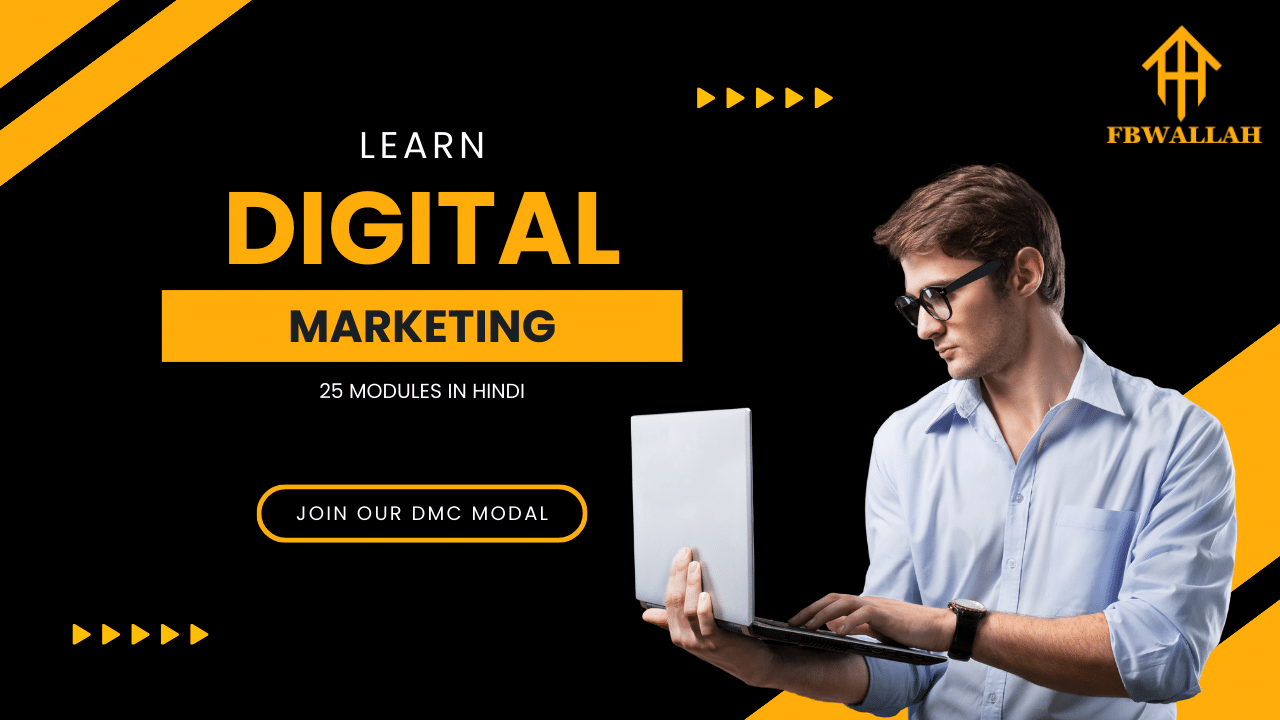
Top 7 Types of Digital Marketing
In the rapidly evolving landscape of online business promotion, understanding the key facets of digital marketing has become crucial for brands aiming to enhance their brand awareness and drive website traffic effectively. According to FBWALLAH, a leader in digital marketing education, the answer to “What are the top 7 types of digital marketing?” encapsulates a broad spectrum of internet marketing techniques designed to optimize online marketing strategies for businesses across a variety of sectors. From leveraging the power of search engine optimization to engaging potential customers through social media platforms, these digital marketing disciplines offer a comprehensive approach to fostering online growth and establishing a robust digital presence.
This article embarks on a detailed exploration of these vital digital marketing dimensions, including search engine optimization (SEO), pay-per-click advertising (PPC), social media marketing, content marketing, email marketing, influencer marketing, and affiliate marketing. Additionally, it delves into the significance of conversion rate optimization (CRO) and the impact of emerging technologies in e-commerce marketing. Aimed at both seasoned professionals in quest of digital marketing analytics enhancement and novices seeking digital marketing courses for career opportunities, such as remote jobs or work from home roles, this guide offers insightful analysis into effective internet advertising strategies, web design, web development, and the pivotal role of digital marketing agencies in sculpting successful online marketing campaigns.
Search Engine Optimization (SEO) (Top 7 Types of Digital Marketing)
Understanding the Importance of SEO for Online Visibility
Search Engine Optimization (SEO) significantly enhances a business’s online presence by increasing its visibility on search engines like Google, Bing, and Yahoo 10. By following Google’s guidelines and implementing best practices, businesses can establish trust and credibility, making them appear more reliable to users 8. SEO not only helps in attracting more customers but also plays a crucial role in a business’s overall digital marketing strategy by making the website more visible, which leads to increased traffic and opportunities to convert prospects into customers 9.
Key SEO Tactics for E-commerce
E-commerce SEO involves optimizing an online store to achieve better rankings and visibility in search results, focusing particularly on category and product pages 12. Effective website SEO for e-commerce includes meticulous keyword research, strategic placement of keywords, and crafting compelling meta tags that draw clicks 13. Additionally, optimizing product pages enhances the user experience and increases the likelihood of conversions by ensuring that product descriptions, titles, and images are SEO-friendly 14.
How SEO Impacts Traffic and Sales
SEO is instrumental in driving organic traffic to e-commerce sites, which is vital for businesses that cannot invest heavily in ads 12. With the right SEO strategies, e-commerce sites can appear in more relevant search results, thereby attracting high-quality traffic that can lead to increased sales and revenue 12. Moreover, SEO provides valuable insights into consumer behavior, which helps businesses tailor their content to meet the needs and desires of their target audience, ultimately influencing their decision-making process and enhancing conversions 89.
Pay-Per-Click Advertising (PPC)
Overview of PPC in E-commerce
Pay-Per-Click (PPC) advertising serves as a fundamental online advertising model where advertisers pay only when a user clicks on their ads. This model is particularly beneficial for e-commerce businesses due to its data-driven nature, scalability, and potential for a healthy return on investment 16. PPC campaigns for e-commerce, or e-commerce PPC, specifically promote an online store and its products across various platforms including search engines, social media networks, and other websites, making it a versatile tool for online business promotion 16.
Benefits of Using PPC for Instant Traffic
PPC advertising is renowned for providing immediate visibility and precise targeting, which are crucial in the highly competitive online retail landscape. It ensures that products are prominently displayed at the top of search engine results, thus driving instant organic traffic to e-commerce sites 23. This model is exceptionally responsive to adjustments, allowing advertisers to quickly change their campaigns based on performance data, thereby optimizing their spend and maximizing return on investment 20. Furthermore, PPC enables businesses to target high-intent audiences who are more likely to convert, thus enhancing the effectiveness of their advertising efforts 20.
Strategies for Optimizing PPC Campaigns
Effective PPC campaign management involves continuous optimization to ensure peak performance. Advertisers should regularly review their account’s performance and make necessary adjustments such as refining keywords, adding negative keywords to reduce wasted spend, and optimizing ad groups and landing pages 1723. Conducting thorough keyword research is essential to identify high-performing and relevant product or service keywords, which form the foundation of any successful PPC campaign 23. Additionally, using ad extensions can increase the visibility and relevance of advertisements, providing more information and encouraging user engagement 23. Regular monitoring and testing of different campaign elements are crucial practices that help in maintaining the effectiveness of PPC advertising efforts 23.
Social Media Marketing
The Role of Social Media in E-commerce Marketing
Social media platforms like Facebook, Instagram, Twitter, and LinkedIn play a pivotal role in e-commerce by enhancing brand visibility and fostering direct customer interactions. These platforms enable businesses to reach a broad audience, drive brand awareness, and boost online sales effectively 27. By utilizing social media for e-commerce, companies can engage with millions of active users, which helps in attracting new customers and increasing customer engagement 27. Moreover, social media serves as a strategic tool to promote and sell products online, leveraging various channels to connect with target audiences and drive conversions 27.
Creating Engaging Content for Various Platforms
Creating content that resonates with the audience is crucial for engagement on social media. It’s important to understand the unique audience and features of each platform, as what works on Facebook might not resonate on Twitter or TikTok 28. For instance, Instagram users are drawn to eye-catching visuals, while Twitter users prefer concise and witty tweets 28. Incorporating multimedia elements like images, videos, or GIFs can significantly enhance engagement, as visual content tends to grab attention more effectively than text alone 28. Additionally, crafting compelling captions and descriptions that spark curiosity can encourage users to engage further with the content 28.
Leveraging Social Media Ads for Increased Sales
Social media advertising is a powerful tool for e-commerce businesses, allowing for targeted campaigns that drive immediate traffic and sales. These ads enable businesses to showcase their products prominently across social media platforms, reaching high-intent audiences who are more likely to convert 25. By understanding the demographics, interests, behaviors, and preferences of their target audience, businesses can craft effective ads that highlight the unique features and benefits of their products, thereby boosting sales and generating leads 27. Moreover, social media ads offer the flexibility to adjust campaigns based on performance data, optimizing spend and maximizing return on investment 25.
Content Marketing
Content marketing stands as a pivotal inbound digital marketing strategy, aimed at drawing potential customers through the provision of high-quality content across various platforms such as search engines, social media, and product review sites 40. Unlike traditional marketing efforts that focus on hard-selling, content marketing’s primary goal is to educate, engage, and entertain the audience with useful and relevant content 40. This approach not only fosters customer loyalty and organic traffic but also significantly boosts conversions and customer retention 40.
Importance of Quality Content in E-commerce
In the realm of e-commerce, the quality of content directly influences a website’s visibility to both search engines and potential customers. Quality content, enriched with valuable information, ensures a higher ranking in search engine results, thereby enhancing the site’s visibility 34. It’s crucial to conduct thorough research to understand what the audience is searching for, allowing for the creation of content that resonates with their needs and improves website rankings 34. However, it’s important to note that search engines penalize websites with irrelevant, repetitive, or copied content, emphasizing the need for original and high-quality content 34.
Types of Content to Drive E-commerce Growth
E-commerce websites benefit from a diverse array of content types, each designed to engage shoppers at different stages of their journey. This includes detailed product descriptions, informative blog articles, engaging videos, and user-generated reviews 37. Such content serves multiple vital functions, including driving traffic, educating buyers, and influencing purchase decisions, all of which are crucial for converting visitors into loyal customers 37. From product descriptions that persuade and inform to blog posts that establish brand authority, the content on e-commerce sites is a blend of information, persuasion, and entertainment crafted to provide value at every touchpoint in the customer journey 37.
Content Marketing Strategies for E-commerce
An effective e-commerce content marketing strategy focuses on understanding and addressing the needs of the target audience. This involves creating compelling content in formats preferred by the audience and disseminating it through channels they frequent 40. The type of content created, whether an eBook, a blog post, or a social media post, largely depends on the business’s goals, such as boosting brand awareness or improving conversions 40. A consistent content strategy is key to avoiding confusion, aligning the brand with its target audience, and adding value over time 40. Additionally, storytelling and social proof in the form of customer reviews and success stories can significantly enhance a brand’s appeal and authenticity, motivating potential customers 40.
FBWALLAH DMC’s content creation strategies exemplify effective content marketing through storytelling, visually captivating content, emotionally resonant content, user-generated content, and engagement and interactivity. These strategies are designed to captivate audiences and encourage social sharing, amplifying brand reach and fostering customer loyalty 4138. By incorporating unexpected elements and delightful experiences, FBWALLAH DMC’s content not only engages the audience but also encourages them to participate actively, further enhancing the brand’s online presence and customer engagement 4138.
Email Marketing
Advantages of Email Marketing in E-commerce
Email marketing serves as a cost-effective and flexible tool for reaching new customers and retaining existing ones, encouraging repeat visits to websites 43. This method is particularly beneficial for e-commerce, where it can significantly boost user engagement, client loyalty, and sales by promoting top deals and essential information 4446. The permission-based nature of email marketing ensures that communications are sent to individuals who have opted to receive them, enhancing engagement levels and the likelihood of conversions 43.
Designing Effective Email Campaigns
Creating effective email campaigns does not require intricate design skills but focuses on fundamental design principles to enhance conversion rates. Key elements include using headlines, the first few lines of text, and bullet points to capture attention, as these are the components most likely to be read 47. The hero section of an email, which is the first visible area below the logo, should contain the most critical information and a clear call to action. This section should make use of large text sizes and prominent imagery to guide the reader 47. Emails must also be optimized for mobile viewing, utilizing a single column layout and ensuring that text and buttons are large enough to be easily readable on small screens 47.
Segmentation and Personalization Techniques
Segmentation and personalization are crucial for enhancing the effectiveness of email marketing campaigns. Segmentation involves dividing the audience into relevant groups to tailor content more specifically, which can lead to a 720% increase in revenue from segmented campaigns 49. Personalization goes a step further by tailoring messages to individual users based on personal data, which can significantly increase customer engagement and sales 4950. Effective personalization requires an understanding of the audience and may involve advanced techniques like hyper-personalization, which adjusts the content dynamically based on user behavior and preferences 50.
Influencer Marketing
Understanding Influencer Marketing in E-commerce
Influencer marketing establishes a relationship between brands and influencers who promote products or services through various media outlets like Instagram and YouTube. Unlike traditional celebrity endorsements, influencer marketing relies on individuals who are viewed as trusted figures within their niche communities, possessing a loyal following and often, relevant knowledge or experience 52. This marketing strategy is not just about popularity; it involves influencers who engage actively with their audience, thereby influencing their lifestyle and purchasing decisions 53.
Choosing the Right Influencers for Your Brand
Selecting the right influencers is crucial for the success of marketing campaigns. Brands should align their values with the influencer’s content and ensure that the influencer’s follower demographics match the target audience 5356. Influencers come in various types, such as nano, micro, macro, and mega influencers, each bringing different levels of reach and engagement 56. Brands must consider factors like the influencer’s engagement rate, content relevance, and past collaborations with similar brands to gauge their effectiveness and alignment with the campaign’s goals 5356.
Measuring the Impact of Influencer Campaigns
To effectively measure the success of influencer campaigns, brands need to set clear, quantifiable goals and actively monitor various key performance indicators (KPIs). These include metrics like reach, impressions, engagement rates, follower growth, and conversion rates 5859. Utilizing tools like affiliate links and UTM parameters allows brands to track specific interactions and assess the influence on sales and customer behavior directly attributable to the campaign 59. Regular analysis of these metrics helps in optimizing strategies and ensuring a high return on investment, making influencer marketing a valuable tool for e-commerce growth 5759.
Affiliate Marketing
Basics of Affiliate Marketing for E-commerce
Affiliate marketing is a robust strategy where affiliates earn commissions by promoting a company’s products, effectively leveraging online word-of-mouth 67. This model benefits both the e-commerce seller, who gains increased sales without upfront advertising costs, and the affiliate, who earns through commission without needing to manage product logistics 65. By using unique affiliate links, sales are tracked from the affiliate’s website to the e-commerce platform, ensuring that affiliates are compensated for the traffic and sales they generate 62.
Building an Affiliate Network to Boost Sales
To maximize the effectiveness of affiliate marketing, e-commerce businesses should focus on building a strong affiliate network. This involves selecting affiliates whose audience aligns with the e-commerce brand’s target demographic, thereby increasing the likelihood of conversions 69. It is crucial to assess potential affiliates on factors such as their performance, online presence, and audience engagement to ensure they can contribute positively to the brand’s marketing goals 69. Additionally, offering a variety of commission models can attract a diverse group of affiliates, broadening the reach and impact of the marketing efforts 69.
Best Practices for Affiliate Marketing Success
Successful affiliate marketing requires a strategic approach centered around quality and trust. Affiliates should prioritize providing genuine value to their audience, focusing on creating high-quality content that addresses the audience’s needs and interests 67. Transparency is also critical; affiliates must disclose their partnerships to maintain trust with their audience 61. To keep the affiliate network effective, e-commerce brands should provide continuous support, including training and regular performance feedback, to help affiliates optimize their campaigns 66. Diversifying traffic sources and employing different marketing strategies such as SEO, social media engagement, and email marketing can also enhance the effectiveness of affiliate efforts 67.
Conversion Rate Optimization (CRO)
The Significance of CRO for E-commerce Sites
Conversion Rate Optimization (CRO) is a critical process for e-commerce sites aiming to increase the percentage of visitors who complete a desired action, such as making a purchase or signing up for a newsletter 73. It involves understanding how users interact with a site, identifying barriers to conversion, and making data-driven decisions to enhance the user experience 73. The ultimate goal of CRO is to boost sales and return on investment (ROI) by making incremental improvements to the website and its content 74. By focusing on CRO, e-commerce businesses can save money on customer acquisition costs and invest more wisely in their marketing strategies 70. Additionally, CRO strategies can significantly improve Google rankings by enhancing the user experience, a key factor considered by search engines 71.
CRO Tools and Techniques for E-commerce
To effectively optimize conversion rates, e-commerce businesses utilize a variety of CRO tools and techniques. These tools fall into four main categories: web analytics tools, behavior analytics tools, testing tools, and lead capture tools 73. Web analytics tools provide quantitative data about website performance, such as bounce rates and session durations, offering insights into where improvements are needed 73. Behavior analytics tools, on the other hand, gather qualitative data about how visitors interact with the site, helping to understand why they behave in certain ways 73. Testing tools, such as A/B testing or multivariate testing, allow businesses to compare and measure changes on the website to determine which versions convert better 73. Lead capture tools give businesses another chance to convert users later by growing their email list through forms and exit-intent popups 73. These tools, when used together, provide a comprehensive approach to understanding and improving the user experience on e-commerce sites.
A/B Testing and User Experience (UX) Improvements
A/B testing, or split testing, is a fundamental technique in CRO that involves comparing two or more versions of a web page to see which performs better in terms of conversions 76. It allows businesses to make data-driven decisions and improve the user experience by identifying and removing consumer pain points 77. For instance, testing different page layouts, product descriptions, or call-to-action (CTA) buttons can reveal what resonates best with the target audience 77. A/B testing is not a one-time activity but a continuous cycle of testing, learning, and implementing changes to optimize the user experience 76. By conducting A/B tests on various elements of the e-commerce site, businesses can identify minor changes that bring significant results, such as reducing the site’s bounce rate or increasing click-through rates 78. Furthermore, understanding customer preferences through A/B testing enables businesses to create more engaging content and marketing assets, ultimately leading to a more user-friendly, engaging, and profitable e-commerce website 78.
Emerging Technologies in E-commerce Marketing
The Impact of AI and Machine Learning
Artificial Intelligence (AI) and Machine Learning (ML) are reshaping the e-commerce landscape by enhancing customer experiences and optimizing business operations. These technologies facilitate personalized shopping experiences by analyzing customer data to provide tailored product recommendations 7980. AI-driven chatbots offer 24/7 customer support, improving engagement and streamlining the sales process 7980. Moreover, AI and ML are instrumental in fraud detection, significantly reducing fraudulent activities by analyzing patterns in customer behavior 7980.
Utilizing AR/VR for Enhanced Shopping Experience
Augmented Reality (AR) and Virtual Reality (VR) are pivotal in transforming the e-commerce sector by offering immersive and interactive shopping experiences. AR allows customers to visualize products in their own space, enhancing their understanding and reducing return rates 828384. VR creates a simulated environment where shoppers can interact with products as if in a physical store, thereby increasing engagement and customer satisfaction 828384. These technologies also enable personalized shopping journeys by adapting virtual environments to individual preferences 8283.
The Future of Voice Search and Shopping
Voice search technology is rapidly becoming integral to e-commerce, driven by advancements in AI and Natural Language Processing (NLP). This technology allows users to perform searches and make purchases through simple voice commands, offering a convenient and user-friendly shopping experience 858687. As voice recognition technology improves, it is expected to become more prevalent in online shopping, providing highly personalized and context-aware shopping experiences 858687. This shift towards voice-first platforms signifies a transformative era in e-commerce, where user interactions are more natural and intuitive 858687.
Conclusion
Navigating the multifaceted world of digital marketing involves a comprehensive understanding of its various strategies, from SEO and PPC to influencer and affiliate marketing, alongside leveraging emergent technologies like AI, AR/VR, and voice search. Each technique, as detailed in this exploration, plays a crucial role in augmenting online visibility, enhancing customer engagement, and driving e-commerce success. Emphasizing the importance of authentic, valuable content and strategic marketing efforts, this guide underscores the significance of adopting a holistic digital marketing approach to achieve sustainable growth and a competitive edge in today’s digital landscape.
As businesses continue to adapt to the digital-first world, tailoring strategies to fit the unique needs and behaviors of their target audience becomes essential. Implementations like A/B testing for CRO or personalized email marketing campaigns showcase the dynamic and responsive nature of effective digital marketing strategies. For personalized guidance on navigating these digital marketing avenues and crafting bespoke strategies for your business, feel free to call Now +91 9555201911. By embracing these insights, companies can unlock profound growth opportunities, fostering stronger connections with their audience and setting a robust foundation for continued success in the evolving digital marketplace.
FAQs
What are the primary forms of digital marketing?
Digital marketing is a broad field that includes several key types aimed at enhancing the digital experience for consumers. The top seven types are: Search Engine Optimization (SEO), Search Engine Marketing (SEM), Content Marketing, Social Media Marketing, Affiliate Marketing, Email Marketing, and Influencer Marketing.
Can you explain the 7 P’s in digital marketing?
Originally, the marketing mix was comprised of four elements: Product, Price, Place, and Promotion. This model was expanded to include three additional Ps: People, Packaging, and Process, making up the comprehensive 7 P’s of digital marketing.
What do the 7 C’s stand for in digital marketing?
The 7 C’s of digital marketing are crucial components that guide marketers in creating and refining their strategies. These include Customer, Content, Community, Context, Convenience, Cohesion, and Conversion.
Are there more than 7 types of digital marketing?
Yes, beyond the commonly cited seven types of digital marketing, there are additional forms as outlined by Rogers. These include Affiliate Marketing, Content Marketing, Email Marketing, Marketing Analytics, Mobile Marketing, Pay-per-Click (PPC), Search Engine Optimization (SEO), and Social Media Marketing, totaling eight distinct types.
Some Articles :-
👉👉 Top 10 Digital Marketing Agencies Near Me
👉👉 Top Digital Marketing Services in Orai: Why FBWALLAH Stands Out
👉👉 FBWALLAH: Leading the Way as the Best Digital Marketing Agency in Lucknow
👉👉 Discover FBWALLAH: The No.1 Digital Marketing Agency in Orai
👉👉 Step-by-Step Guide to Finding and Excelling in Digital Marketing Remote Jobs















